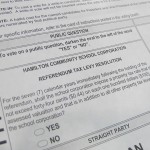Why The Property Tax Cap Amendment Doesn't Ensure Schools Are Funded Equally
| District Revenues From Property Taxes | |
|---|---|
| Indianapolis Public School | $118,570,305.00 |
| Hamilton Southeastern School Corporation | $64,781,415.00 |
| Gary Community School Corporation | $25,499,337.00 |
| Shakamak School Corporation | $1,360,181.00 |
Here are a few:
- Hamilton Southeastern Schools, in Fishers, passed a $5.5 million general fund referendum in November 2009. They also passed a construction referendum in November 2010.
- Carmel Clay Schools, in Carmel, passed a $0.16 per hundred dollars in assessed value referendum in May 2009.
- Crown Point Community School Corporation, in Crown Point, passed a $0.21 per hundred dollars in assessed value referendum in May 2011.
All of these cities have average individual incomes above the state average.
But what about in communities where individuals make less than the state’s $25,000 average?
According to the US Census Bureau, predominantly-rural Greene County has a poverty rate of more than 16 percent, with an average individual income of $20,945 — a full $10,946 less than in Fishers.
| City | Poverty Rate |
|---|---|
| Indianapolis | 11.90% |
| Gary | 25.80% |
| Linton (Green County) | 16.60% |
| Fishers | 1.80% |
District officials in rural Indiana often take on a fatalistic tone when discussing the property tax cap amendment. Frequently, the conversation ends with little more than the phrase, “The voters have spoken.”
Rural school funding has been hit hard, not only by the property tax caps, but also by declining enrollment and cuts in per pupil funding from the state.
Things are less clear in Indiana’s urban areas. In response to Governor Mitch Daniels’ initial plan to cap property tax rates, Indianapolis Public Schools Superintendent Eugene White told WTHR the system would for his district to pay the same bills with less money.
“We have a responsibility, an obligation and a duty to ensure that our students receive a quality education,” said Indianapolis Public Schools Superintendent Eugene White. “We have to pay for that.”
Case in point: Gary Community School Corporation, located in a city of 80,292 residents, raised $25.5 million in property tax revenue during the most recent fiscal year.
Hamilton Southeastern School Corporation, in the smaller city of Fishers (population 76,794), raised more than twice that amount in property taxes, collecting more than $64.8 million.
The four thousand fewer residents of Fishers generated $40 million more in property tax revenue than Gary.
In the case of Gary, schools are receiving less in property tax revenue per student than Fishers.
Funding issues in Indianapolis are less clear. Indianapolis Public Schools raised $118.5 million in property tax revenue. With a total enrollment 33,372 students, that averages out to $3,551 per pupil. This is only $40 less per student than Fishers.

